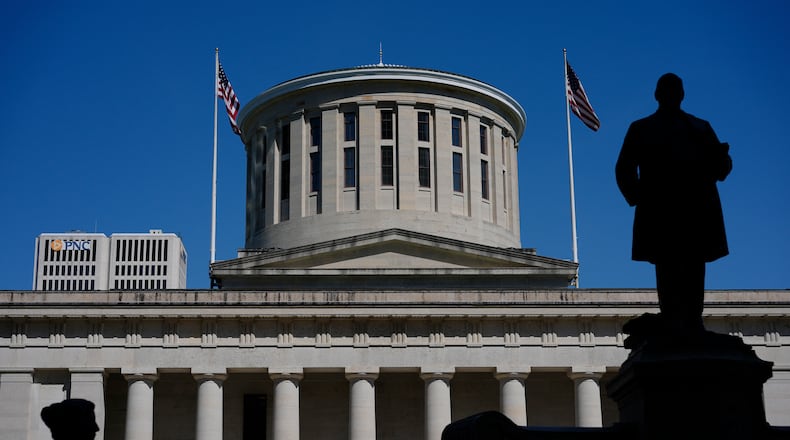The House’s proposal cuts a $61 billion proposed budget from Republican Gov. Mike DeWine down to $60 billion in state general revenue funds, with sweeping eliminations to some of the governor’s most notable proposals.
“I think our budget kind of speaks for itself and what we thought of some of the proposals,” Ohio House Finance Chair Brian Stewart, R-Ashville, told reporters Tuesday.
Browns stadium
House Republicans canceled DeWine’s proposal to double Ohio’s gambling tax, which the governor hoped would raise enough money to allow the state to shell out money to professional sports franchises’ stadiums and to help students afford extracurricular activities.
DeWine’s plan followed the Cleveland Browns asking the state to supplement the construction of a new domed stadium and entertainment grounds in a Cleveland suburb.
The House’s new proposal sets aside the authority for the state to issue and sell up to $600 million in state bonds “to help finance the Cleveland Browns stadium megaproject in the city of Brook Park,” according to a House document.
Conversations between the Browns and the legislature have been ongoing. Stewart said on Tuesday that the project promises to bring a preeminent entertainment venue, and perhaps the capacity to host the Super Bowl, to Cleveland.
House GOP leaders have been soothed by the idea of raising the funds through public bonds at a rate of about $30 million per year rather than directly using taxpayer funds. Stewart said lawmakers also like the Browns’ supposed offer to put up collateral of a $38 million investment, expected to grow to about $120 million to $130 million by the end of the bond payments.
“We believe that the metrics are that we will generate enough tax revenue from that project to pay back those bonds in their entirety,” Stewart told reporters. “But if those projections are off at all ... we then have $130 million to plug and pay off the rest of those bonds and make sure the taxpayers are made whole.”
The House’s plan doesn’t, however, create a permanent game plan the state can follow for future occasions a franchise asks for state help, which was the primary goal of DeWine’s plan.
“Maybe we’ll have an opportunity to talk about a larger, more general source of funding that could be used for cultural facilities like this. Moving forward, I would agree that we need to kind of identify some rules of the road,” Stewart said.
Child care
Also snuffed was DeWine’s proposal to significantly increase tobacco taxes and use the revenues to fund up to $1,000 refundable tax credits for every child under seven years old.
Instead, the House GOP plan creates a $10 million pilot program that splits child care costs three ways: 40% on participating employers, 40% on employees, and 20% on the state. This “triage” subsidy, like DeWine’s approach, is meant to get more Ohioans back in the workforce as jobs outpace workers.
State Rep. Andrea White, R-Kettering, who has consistently pushed for the state to increase its child care subsidies, told this outlet she’ll look for more opportunities to add solutions to the state budget.
“I think any and all options that we can fund to expand access, availability and affordability of child care is important,” said White.
While the pilot program is considerably less of a commitment than DeWine’s proposed credits, White noted that she was pleased with the $10 million figure, as it’s more than other states have put into similar programs. She hopes business take advantage of the program and prove its effectiveness.
Public school funding
The House’s plan will put approximately $226 million more state dollars towards public K-12 education than DeWine’s plan would have, but school funding advocates still warn that it severely undercuts what the state has been working toward over the past four years.
House Finance Committee Ranking Member Bride Rose Sweeney, D-Westlake, who helped develop a plan the state has used over the past three budgets to gradually shift the school funding onus away from property tax payers and onto the state, told reporters Tuesday that the House plan doesn’t do enough to fix DeWine’s plan.
“What is being produced is likely one of the lowest state shares in the state’s history, even with what they’ve put forward today, meaning that it’s even less state money going into our schools than when this was deemed unconstitutional,” Sweeney told reporters. “Who is paying for that? Property owners across the board who are gonna be asked to pay more so we (the state) can pay less. That is wrong.”
In a text to this outlet, Sweeney said the House’s funding plan undercuts a fully-implemented fair school funding plan by roughly $1.5 billion over the biennium.
House Republicans, however, argue that under their plan, no district will receive less in state aid in fiscal years 2026 and 2027 than they did in fiscal year 2025. In particular, the House plan adjusted the state formula to grant more money to growing districts.
For more stories like this, sign up for our Ohio Politics newsletter. It’s free, curated, and delivered straight to your inbox every Thursday evening.
Avery Kreemer can be reached at 614-981-1422, on X, via email, or you can drop him a comment/tip with the survey below.
About the Author

